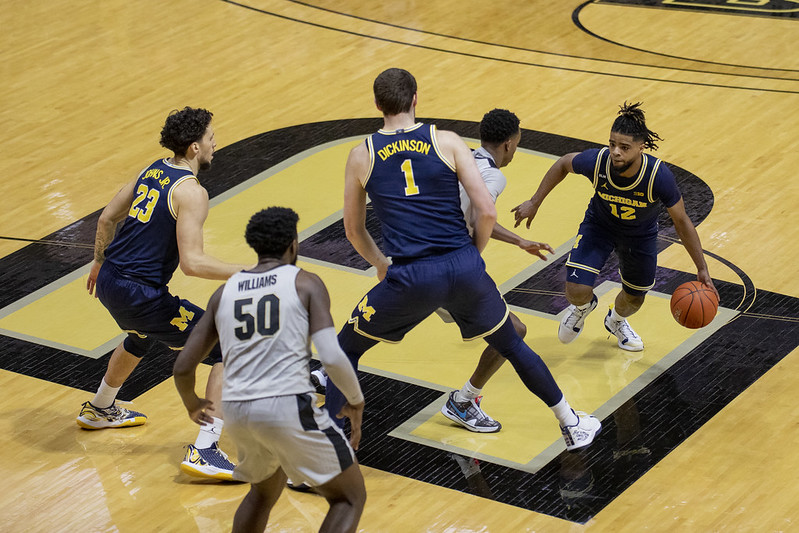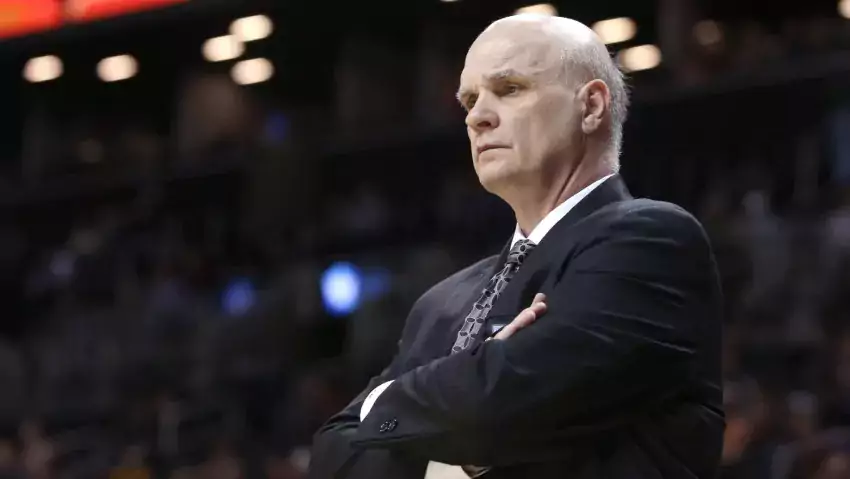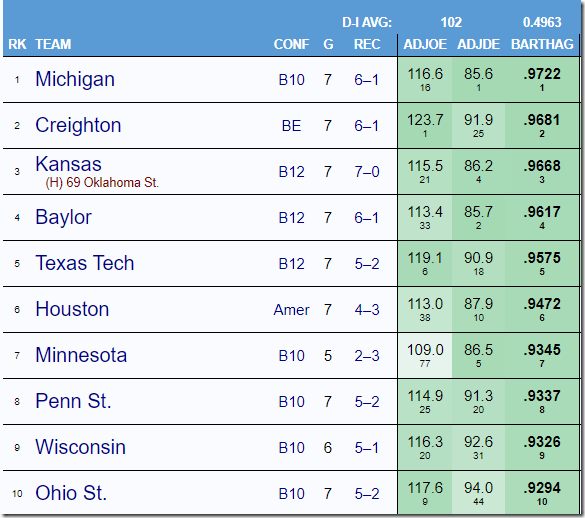howard eisley

Mike Smith Starts Putting It Together

increasingly dangerous [Campredon]
As opposing defenses have placed a greater emphasis on stopping Hunter Dickinson, the court has opened up for other Wolverines to step forward. The primary beneficiary has been point guard Mike Smith, who's increasing his shot attempts from beyond the arc while slicing his previously problematic turnover numbers in half.
After removing the season-opening cupcakes, the statistical comparison between early-season Smith and the version we've seen since the Minnesota loss is stark. Everything has stayed level except for missing a couple more two-pointers (almost certainly a sample size issue), attempting an extra three-pointer per 100 possessions (given his numbers, great!), and trading off an assist or two per game to cut out an equal number of turnovers, which has been a very worthwhile swap. The result is an 11-point jump in O-Rating, per Bart Torvik:
| ORtg | ARate | TORate | 2PM-2PA | 3PM-3PA | 3PA/100 | FTM-FTA | FTRate | PPG | APG | TOPG | |
|---|---|---|---|---|---|---|---|---|---|---|---|
| Prev. 9 Games | 106.0 | 29.5 | 30.2 | 14-33 (42.4%) | 11-22 (50.0%) | 4.6 | 12-15 (80.0%) | 27.3 | 8.1 | 6.0 | 3.0 |
| Last 5 Games | 117.2 | 26.3 | 16.0 | 7-22 (31.8%) | 8-14 (57.1%) | 5.5 | 7-10 (70.0%) | 27.8 | 9.0 | 4.6 | 1.4 |
The increased attention on Dickinson has helped Smith. The more important factor, though, is his improved comfort level against the size and speed of Big Ten defenses. A lot of his turnovers earlier in the year were passes that didn't make it through the crowd.
You can see the game slowing down for him. The little hesitation move on this pick-and-roll drive forces the defense to commit before Smith makes the pass, which allows him time to make the correct read to find the right angle to get the ball through clean:
Over the full season, Smith is posting strong numbers as a pick-and-roll ballhandler when you include his passes. He’s slightly above-average as a scorer but his passing puts him in the 85th percentile overall as a P&R ballhandler anyway. If he keeps the turnovers down, the efficiency of these plays will take a substantial leap, too:
| %Time | Poss | Points | PPP | %ile | FG | eFG% | TO% | FT% | Score% | |
|---|---|---|---|---|---|---|---|---|---|---|
| Smith Shot/TO | 33.8 | 69 | 54 | 0.783 | 60th | 21-46 | 48.9 | 26.1 | 7.2 | 36.2 |
| Smith Pass | 66.2 | 135 | 155 | 1.148 | 81st | 61-113 | 63.7 | 11.9 | 5.2 | 48.9 |
| OVERALL | — | 204 | 209 | 1.025 | 85th | 82-159 | 59.4 | 16.7 | 5.9 | 44.6 |
Smith has done a nice job of spreading his passes between kickouts to shooters, dumpoffs to the roll man, and quick-hitters to the occasional cutter. Finding the big man on the roll is generally the most efficient way to end a ball screen for any team—save for hitting cutters, because when that happens the other team usually fell asleep, and that happens far less often—and Michigan is no exception with Hunter Dickinson usually on the receiving end of those plays.
Only two Big Ten players, D’Mitrik Trice and Marcus Carr, have hit the roll man more than the 44 times Smith’s posted this season and neither crack a point per possession on those plays while Smith’s in elite territory at 1.23:
| %Time | Poss | Points | PPP | %ile | FG | eFG% | TO% | FT% | Score% | |
|---|---|---|---|---|---|---|---|---|---|---|
| Roll Man | 32.6 | 44 | 54 | 1.227 | 80th | 23-33 | 72.7 | 18.2 | 6.8 | 59.1 |
| Spot Up | 57.8 | 78 | 82 | 1.051 | 72nd | 29-68 | 63.7 | 10.3 | 2.6 | 39.7 |
| Cutter | 9.6 | 13 | 19 | 1.462 | 83rd | 9-12 | 75.0 | 0.0 | 15.4 | 69.2 |
| OVERALL | — | 135 | 155 | 1.148 | 81st | 61-113 | 63.7 | 11.9 | 5.2 | 48.9 |
Smith has increasingly gone to the bounce pass, which turns his height (or lack thereof) into an asset instead of a detriment as he threads the needle between taller defenders:
His skip passes are getting through more often, too.
[Hit THE JUMP for Smith's P&R scoring and lethal transition work, plus updates on the BTT, an injury to Ayo Dosonmu, and more.]

2/22/2020 – Michigan 71, Purdue 63 – 18-9, 9-7 Big Ten
Back in November, Michigan lost a game at Illinois in which they shot 3/18 from three. I surveyed Michigan's available roster, which was a bunch six-foot guards, a beanpole freshman, a guy Juwan Howard describes as a "big guard" playing the four, and Jon Teske, and decided that this was not a team that was going to overcome that kind of brickfest:
3/18 from three, the end
— mgoblog (@mgoblog) December 12, 2019
It is late February and Michigan has won consecutive road games against teams close to the NCAA cutline. They shot 6/23 from three in one, 6/25 in the other. In this one Zavier Simpson was 0/10 from the floor. Michigan shot 24% from three; their star point guard didn't score until Eat Your Liver Time; Michigan led by about 15 points most of the second half. The Aristocrats!
Avid Torvik slicers are all over the internet telling anyone who will listen that Michigan is college basketball's best team in the month of February. It's true.
2-3 Minnesota is in there on the back of a blowout of Northwestern, so grain of salt and all that. But Michigan's vaunted defense has returned after a troubling midseason lull. That rebound allows Michigan to go on the road and clank a bunch of shots and win games.
Hit some damn shots and there's nobody in the country save maybe Kansas and Baylor who's coming out unscathed.
The turnaround in four numbers. Michigan from behind the line in January:
- OFFENSE: 26.8%, #329 nationally
- DEFENSE: 40.2%, #341 nationally
In February:
- OFFENSE: 35.6%, #94 nationally
- DEFENSE: 25.8%, #19 nationally
On the season Michigan is #105 on O and #44 on D. The January numbers were ludicrously unlucky; the February numbers are probably a little kind but are much closer to Michigan's season-long performance levels. Having Livers for big chunks of February helps, and further points towards this being the Real Michigan.
[After THE JUMP: T-Minus some number for Franz liftoff.]

Michigan has a couple of assistant coaches. One of them, Phil Martelli, has a track record so long that he's literally the entire history of a school on Kenpom. The other one not so much. The guy with the copy and paste first.
PHIL MARTELLI: SQUINT AND IT'S BEILEIN-ISH
Martelli took over St Joe's after an extended low point. The Hawks hadn't been to an NCAA tournament since 1986 when he was hired a decade later; in Martelli's second year he snagged a four seed and reached the Sweet 16. Three losing conference seasons followed, and then Martelli began what's probably the greatest five-year span in St Joe's history. The Hawks went 68-12 in conference, won the A10 five straight times, got three NCAA bids, and reached the Elite 8 as a one seed after an undefeated regular season featuring a Jameer Nelson/Delonte West backcourt.
After this belle epoque St Joe's settled into a 14-year period of meh. From 2005-06 to this year St Joe's never finished higher than third in the A10 and acquired three bids, advancing to the second round once. It was rare for St Joe's to have a legitimately bad team during this period, but Martelli would never approach those heights again.
Two things ultimately sunk Martelli's tenure: a new athletic director and a spate of injuries. This year's Three Man Weave A10 preview:
Outlook: Will it ever stop? St. Joe’s has been crushed by injuries for two consecutive seasons, derailing potential A-10 contenders before they could ever really get going. Shavar Newkirk went down early in 2016-17, eventually followed by his point guard counterpart, Lamarr “Fresh” Kimble, and Pierfrancesco Oliva missed the entire season due to a knee injury. Then, Kimble managed only one game in 2017-18 before succumbing to the very same injury, a broken fifth metatarsal in his left foot. Of course, that was one more game than promising sophomore Charlie Brown got to play after fracturing his wrist in mid-October, and just like that, the Hawks were down two key pieces one game into the season. Despite that, they still clawed to a 10-8 league record, and with those two back healthy this year, there’s reason for optimism in northwest Philly.
It did not stop. Oliva played in just 13 games before going out for the year in mid-January. Kimble missed 10 games in the heart of the conference schedule. St Joe's went 6-12 in A10 play and that was that.
Martelli's tenure was so long that it's impossible to judge what a normal level for St Joe's is. It's probably something approximating the meh portion of Martelli's career. The school is a small (under 5k undergrads) Jesuit institution that had been to one Sweet 16 since 1966 when he was hired. The arena is a tiny band-box with a capacity of 4,200. Until 2009 its capacity was 3,200. Membership in Philly's Big 5 counts for something; it's unlikely Martelli's successor is going to improve on even the desultory late period.
[After THE JUMP: Martelli's style of play and recruiting, plus everything I could find about Howard Eisley, which was not much.]

okay now recruit three guys immediately

12